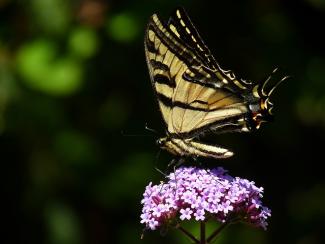
Image Credit: Mathesont
Butterflies (all families except Satyridae) are herbivores. Most butterfly activity is nectar-feeding. Active butterflies spend only a very small percentage of their time visiting flowers (probably mostly at the start of the day). Though they can imbibe nectar from bowl-shaped flowers, they generally prefer tube-shaped flowers. Butterflies are less efficient than bees at moving pollen between plants. The have long thin legs with which they perch high above the flower, so they do not pick up much pollen on their bodies. Butterflies don’t have specialized structures like the pollen-collecting hairs or scopa on bees, for collecting pollen.
Caterpillars are an important food source for birds. Collecting moths in the late spring and summer is one way to assess the abundance and diversity of caterpillars in your area. Different insects fly for different distances, and lights in contrasting habitats are visible for different distances. Try to place your light in a position that maximizes its visibility no matter what. This will really help comparisons with other projects in other environments.
You can capture adult lepidoptera on camera, using nets, and using light traps. Light traps are dependent on availability of electricity. If electricity is present, the most efficient trap is a fluorescent bulb hung in front of a white bed sheet. Always let the base of the bed sheet rest on the ground surface; pull the base of the bed sheet forwards, which allows the incoming fliers to hit the sheet and fall down but remain on a visible background. If batteries are necessary, do not underestimate the difficulty of lugging car batteries around. Light traps are sold by BioQuip
You can also assess butterfly species occurance visually by photographing the butterfly when you see it and then identifying it using our picture guide. You can collect caterpillars via branch beating and identify it using this guide.